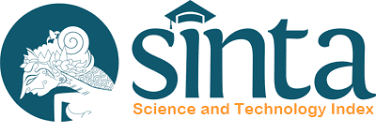Implementasi Metode SVM-PSO Dengan Fitur Selection Variance Threshold Pada Klasifikasi Penyakit Diabetes Mellitus
DOI:
https://doi.org/10.26555/jim.v10i2.30877Keywords:
SVM-PSO ,, Variance Threshold,, Klasifikasi ,, Diabetes Mellitus,, Optimasi ,Abstract
Pada penelitian ini membahas tentang kasus klasifikasi pada data penyakit diabetes. Metode yang digunakan dalam penelitian ini adalah metode Support Vector Machine yang dioptimalkan dengan algoritma Particle Swarm Optimization guna memperoleh parameter terbaik dengan kombinasi seleksi fitur menggunakan Variance Threshold. Penelitian ini bertujuan untuk mengetahui cara kerja dan hasil akurasi dari metode Support Vector Machine dengan optimasi Particle Swarm Optimization menggunakan seleksi fitur Variance Threshold. Hasil penelitian menggunakan kombinasi metode tersebut menunjukkan hasil akurasi sebesar 80%. Hasil akurasi tersebut lebih tinggi jika dibandingkan dengan metode Support Vector Machine tunggal tanpa optimasi dan seleksi fitur dengan akurasi sebesar 76%. Meningkatkan akurasi sebesar 4% dari 76% menjadi 80%.
References
C. Sreedhar, N. Kasiviswanath, and P. Chenna Reddy, “Clustering large datasets using K-means
modified inter and intra clustering (KM-I2C) in Hadoop,” J. Big Data, vol. 4, no. 1, 2017, doi:
10.1186/s40537-017-0087-2.
S. Agarwal, “Data Mining: Data Mining Concepts and Techniques,” pp. 203–207. doi:
10.1109/ICMIRA.2013.45.
M. North, Data Mining for the Masses. 2012. [Online]. Available: http://1xltkxylmzx3z8gd647akcdvov.wpengine.netdna-cdn.com/wpcontent/uploads/2013/10/DataMiningForTheMasses.pdf%5Cnhttps://sites.google.com/site/dataminingforthemasses/
V. N. Vapnik, The Nature of Statistical Learning Theory. 2nd ed.: Springer Verlag, 1995.
T. Sousa, A. Silva, and A. Neves, “Particle Swarm based Data Mining Algorithms for classification
tasks,” Parallel Comput., vol. 30, no. 5–6, pp. 767–783, 2004, doi: 10.1016/j.parco.2003.12.015.
J. H. Joloudari, H. Saadatfar, A. Dehzangi, and S. Shamshirband, “Computer-aided decision-making
for predicting liver disease using PSO-based optimized SVM with feature selection,” Informatics
Med. Unlocked, vol. 17, no. October, p. 100255, 2019, doi: 10.1016/j.imu.2019.100255.
D. Saputra, W. S. Dharmawan, and W. Irmayani, “Performance Comparison of the SVM and SVMPSO Algorithms for Heart Disease Prediction,”Int.J.Adv.DataInf.Syst.,vol.3,no.2,pp.74–86,2022,doi:10.25008/ijadis.v3i2.1243.
D. Saputra, W. Irmayani, D. Purwaningtias, and J. Sidauruk, “A Comparative Analysis of C4.5
Classification Algorithm, Naïve Bayes and Support Vector Machine Based on Particle Swarm
Optimization (PSO) for Heart Disease Prediction,” Int. J. Adv. Data Inf. Syst., vol. 2, no. 2, pp. 84–
95, 2021, doi: 10.25008/ijadis.v2i2.1221.
Z. Song, S. Liu, M. Jiang, and S. Yao, “Research on the Settlement Prediction Model of Foundation
Pit Based on the Improved PSO-SVM Model,” Sci. Program., vol. 2022, 2022, doi:10.1155/2022/1921378.
I. Behravan, O. Dehghantanha, and S. H. Zahiri, “An optimal SVM with feature selection using
multi-objective PSO,” 1st Conf. Swarm Intell. Evol. Comput. CSIEC 2016 - Proc., vol. 2016, pp. 76–
81, 2016, doi: 10.1109/CSIEC.2016.7482135.
Y. Saeys, I. Inza, and P. Larrañaga, “A review of feature selection techniques in bioinformatics,”
Bioinformatics, vol. 23, no. 19, pp. 2507–2517, 2007, doi: 10.1093/bioinformatics/btm344.
H. Bai, “Preparing Teacher Education Students to Integrate Mobile Learning into Elementary
Education,” TechTrends, vol. 63, no. 6, pp. 723–733, Nov. 2019, doi: 10.1007/s11528-019-00424z.
F. Giannakas, A. Papasalouros, G. Kambourakis, and S. Gritzalis, “A comprehensive cybersecurity
learning platform for elementary education,” Inf. Secur. J. A Glob. Perspect., vol. 28, no. 3, pp. 81–
106, May 2019, doi: 10.1080/19393555.2019.1657527.
R. M. Vink et al., “Self-reported adverse childhood experiences and quality of life among children
in the two last grades of Dutch elementary education,” Child Abuse Negl., vol. 95, p. 104051, Sep.
2019, doi: 10.1016/j.chiabu.2019.104051.
Downloads
Published
Issue
Section
License
Copyright (c) 2025 Pratiwi Kistiya Ningrum, Joko Purwadi

This work is licensed under a Creative Commons Attribution-NonCommercial-ShareAlike 4.0 International License.
Authors who publish with this journal agree to the following terms:
1. Authors retain copyright and grant the journal right of first publication with the work simultaneously licensed under a Creative Commons Attribution License that allows others to share the work with an acknowledgment of the work's authorship and initial publication in this journal.
2. Authors are able to enter into separate, additional contractual arrangements for the non-exclusive distribution of the journal's published version of the work (e.g., post it to an institutional repository or publish it in a book), with an acknowledgment of its initial publication in this journal.
3. Authors are permitted and encouraged to post their work online (e.g., in institutional repositories or on their website) prior to and during the submission process, as it can lead to productive exchanges, as well as earlier and greater citation of published work.

This work is licensed under a Creative Commons Attribution-ShareAlike 2.0 Generic License.









